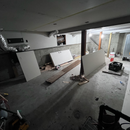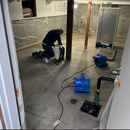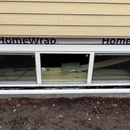Cement Wall Vapor Barrier in Uninsulated Basement?
I live in climate zone 4C (Seattle area) and am trying to reduce relative humidity levels in my basement (picture attached) to improve storage down there. We will not drywall over the cement walls. We do not heat the basement, but our mechanical equipment and ducting down there seem to keep it roughly 55F all year.
We are using primer + latex paint on the sheet-rocked ceiling and an un-insulated halfwall (behind which there is only crawlspace). We have a large amount of surface area of below-grade concrete walls and I’m wondering if applying DryLok is a bad idea. The concrete is decades old and there is no exterior water proofing or insulation of any kind. We do have a sump pump, but, when that is working, have no issues with wet floors and I’ve never noticed visible moisture on the walls.
My hope is that DryLok will add a touch of brightness & color while keeping water vapor intrusion and thus relative humidity to a minimum… however, I see the perms rating is only “< 1”, so now I’m wondering if this really is going to make a difference. On the other hand, BSC’s documents on basement walls have me wondering if I should be trying to reduce water vapor intrusion at all (https://buildingscience.com/documents/digests/bsd-103-understanding-basements).
Perhaps complicating things is that some of our original mud sill is untreated cedar and in direct contact with the stemwall. If I trap moisture in the wall, will that also affect the ability of the mud sill to dry when necessary? (If so, can I leave some number of inches of the perimeter around the windows un-painted to help with this?)
I may try to add exterior insulation to the top few feet below grade someday… will using DryLok now make that an issue later? (moisture sandwich?)
Is there a better product I should be using?
Thanks!
GBA Detail Library
A collection of one thousand construction details organized by climate and house part













Replies
perhaps Drylock & a layer of Thermax? Thermax has aluminum foil on both sides - so stops moisture transfer & it's fire rated for use in living spaces.
Much appreciated! Someday I’ll likely put some ground contact rated foil backed foam on the outside (top couple of feet below grade, at least), but for now insulation is outside the budget unfortunately.